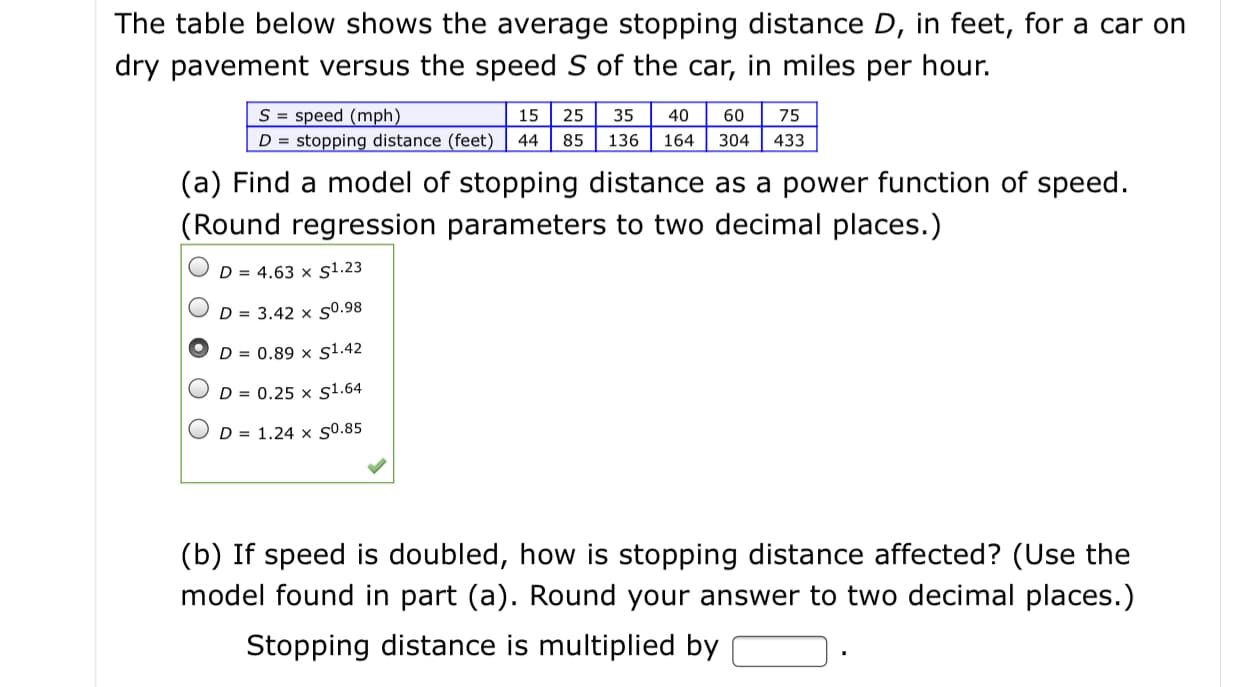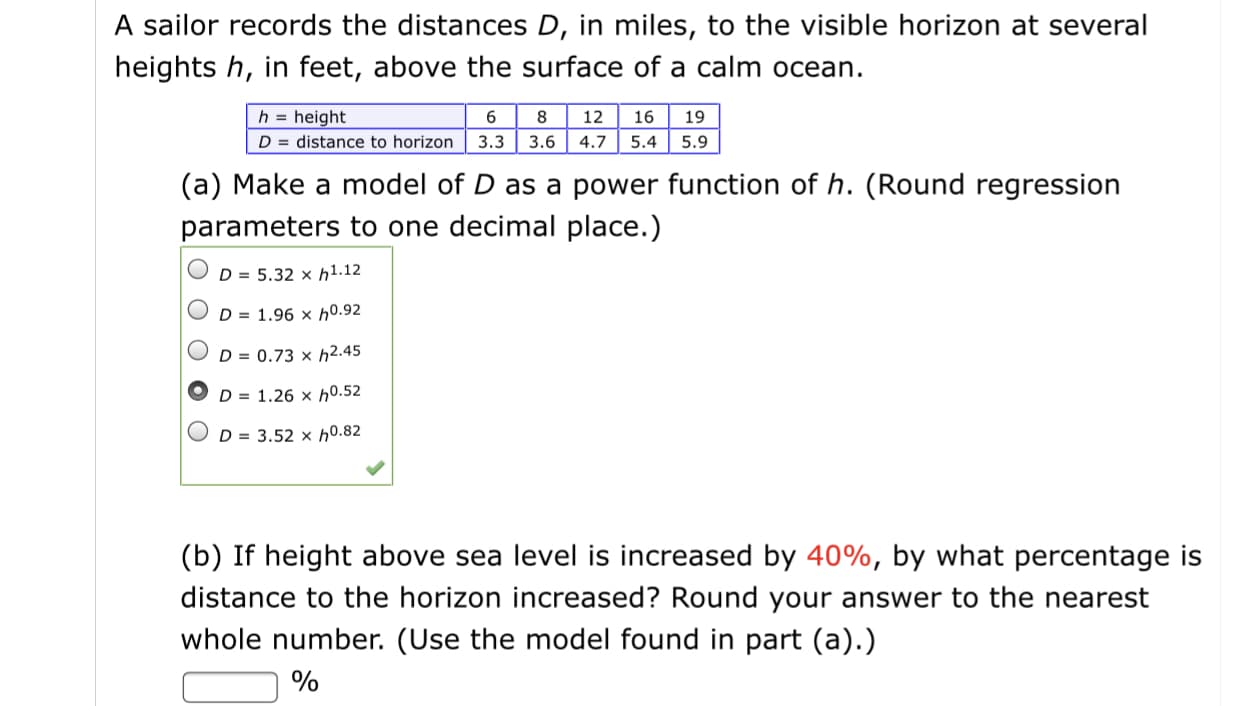The table below shows the average stopping distance D, in feet, for a car on dry pavement versus the speed S of the car, in miles per hour. S = speed (mph) D = stopping distance (feet) 15 25 35 40 60 75 44 85 136 164 304 433 (a) Find a model of stopping distance as a power function of speed. (Round regression parameters to two decimal places.) D = 4.63 × s1.23 D = 3.42 × s0.98 D = 0.89 × s1.42 D = 0.25 × s1.64 D = 1.24 × s0.85 (b) If speed is doubled, how is stopping distance affected? (Use the model found in part (a). Round your answer to two decimal places.) Stopping distance is multiplied by A sailor records the distances D, in miles, to the visible horizon at several heights h, in feet, above the surface of a calm ocean. h = height D = distance to horizon 3.3 12 16 19 3.6 4.7 5.4 5.9 (a) Make a model of D as a power function of h. (Round regression parameters to one decimal place.) D = 5.32 × h1.12 D = 1.96 × h0.92 D = 0.73 × h2.45 D = 1.26 × h0.52 D = 3.52 × h0.82 (b) If height above sea level is increased by 40%, by what percentage is distance to the horizon increased? Round your answer to the nearest whole number. (Use the model found in part (a).)
The table below shows the average stopping distance D, in feet, for a car on dry pavement versus the speed S of the car, in miles per hour. S = speed (mph) D = stopping distance (feet) 15 25 35 40 60 75 44 85 136 164 304 433 (a) Find a model of stopping distance as a power function of speed. (Round regression parameters to two decimal places.) D = 4.63 × s1.23 D = 3.42 × s0.98 D = 0.89 × s1.42 D = 0.25 × s1.64 D = 1.24 × s0.85 (b) If speed is doubled, how is stopping distance affected? (Use the model found in part (a). Round your answer to two decimal places.) Stopping distance is multiplied by A sailor records the distances D, in miles, to the visible horizon at several heights h, in feet, above the surface of a calm ocean. h = height D = distance to horizon 3.3 12 16 19 3.6 4.7 5.4 5.9 (a) Make a model of D as a power function of h. (Round regression parameters to one decimal place.) D = 5.32 × h1.12 D = 1.96 × h0.92 D = 0.73 × h2.45 D = 1.26 × h0.52 D = 3.52 × h0.82 (b) If height above sea level is increased by 40%, by what percentage is distance to the horizon increased? Round your answer to the nearest whole number. (Use the model found in part (a).)
Functions and Change: A Modeling Approach to College Algebra (MindTap Course List)
6th Edition
ISBN:9781337111348
Author:Bruce Crauder, Benny Evans, Alan Noell
Publisher:Bruce Crauder, Benny Evans, Alan Noell
Chapter5: A Survey Of Other Common Functions
Section5.3: Modeling Data With Power Functions
Problem 2TU
Related questions
Question

Transcribed Image Text:The table below shows the average stopping distance D, in feet, for a car on
dry pavement versus the speed S of the car, in miles per hour.
S = speed (mph)
D = stopping distance (feet)
15
25
35
40
60
75
44
85
136
164
304
433
(a) Find a model of stopping distance as a power function of speed.
(Round regression parameters to two decimal places.)
D = 4.63 × s1.23
D = 3.42 × s0.98
D = 0.89 × s1.42
D = 0.25 × s1.64
D = 1.24 × s0.85
(b) If speed is doubled, how is stopping distance affected? (Use the
model found in part (a). Round your answer to two decimal places.)
Stopping distance is multiplied by

Transcribed Image Text:A sailor records the distances D, in miles, to the visible horizon at several
heights h, in feet, above the surface of a calm ocean.
h = height
D = distance to horizon 3.3
12
16
19
3.6
4.7
5.4
5.9
(a) Make a model of D as a power function of h. (Round regression
parameters to one decimal place.)
D = 5.32 × h1.12
D = 1.96 × h0.92
D = 0.73 × h2.45
D = 1.26 × h0.52
D = 3.52 × h0.82
(b) If height above sea level is increased by 40%, by what percentage is
distance to the horizon increased? Round your answer to the nearest
whole number. (Use the model found in part (a).)
Expert Solution
This question has been solved!
Explore an expertly crafted, step-by-step solution for a thorough understanding of key concepts.
This is a popular solution!
Trending now
This is a popular solution!
Step by step
Solved in 2 steps with 2 images

Recommended textbooks for you

Functions and Change: A Modeling Approach to Coll…
Algebra
ISBN:
9781337111348
Author:
Bruce Crauder, Benny Evans, Alan Noell
Publisher:
Cengage Learning

Algebra & Trigonometry with Analytic Geometry
Algebra
ISBN:
9781133382119
Author:
Swokowski
Publisher:
Cengage

Big Ideas Math A Bridge To Success Algebra 1: Stu…
Algebra
ISBN:
9781680331141
Author:
HOUGHTON MIFFLIN HARCOURT
Publisher:
Houghton Mifflin Harcourt

Functions and Change: A Modeling Approach to Coll…
Algebra
ISBN:
9781337111348
Author:
Bruce Crauder, Benny Evans, Alan Noell
Publisher:
Cengage Learning

Algebra & Trigonometry with Analytic Geometry
Algebra
ISBN:
9781133382119
Author:
Swokowski
Publisher:
Cengage

Big Ideas Math A Bridge To Success Algebra 1: Stu…
Algebra
ISBN:
9781680331141
Author:
HOUGHTON MIFFLIN HARCOURT
Publisher:
Houghton Mifflin Harcourt

College Algebra
Algebra
ISBN:
9781305115545
Author:
James Stewart, Lothar Redlin, Saleem Watson
Publisher:
Cengage Learning

Algebra and Trigonometry (MindTap Course List)
Algebra
ISBN:
9781305071742
Author:
James Stewart, Lothar Redlin, Saleem Watson
Publisher:
Cengage Learning
